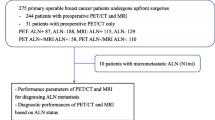Abstract
Objective
To determine diagnostic accuracy of SPECT, CT and SPECT-CT in axillary lymph node (LN) staging in breast cancer (BC).
Methods
Sixty consecutive patients with primary operable T1-3NxM0 BC were included in this study. All patients underwent SPECT-CT examination on Symbia-T16 scanner which consists of dual-head gamma camera combined with 16 slices diagnostic CT. SPECT-CT acquisition started 10–15 min after i/v injection of 740–1,000 MBq of 99mTc-MIBI. On CT images of axillary LN we analyzed following diagnostic signs: size (short axis more or less than 10 mm), shape (round or oval), cortical thickness and fat content (solid or with fat gate). Intensity of tracer uptake in axillary LN was classified as follows: grade (Gr) I—background, Gr II—slightly above background, Gr III—intense but below uptake in muscles, Gr IV—as high as in muscles. Histological examination of dissected LN was used as gold standard.
Results
Various combinations of CT signs of axillary LN involvement demonstrated moderate diagnostic value with best results characterized by low (55 %) sensitivity (SEN), 97 % specificity (SP) and 83 % accuracy (AC). Intensive (Gr IV) uptake of 99mTc-MIBI in axillary LN characterized by low (55 %) SEN, high (100 %) SP and moderate (84 %) AC. Combination of CT and SPECT signs looks most promising especially when LN metastases were diagnosed in patients with enlarged solid LN or normal sized LN with Gr III-IV 99Tc-MIBI uptake. In these cases, SEN was equal to 75 %, SP-90 %, AC-85 %, only one of 5 patients with false negative results had metastases in more than 2 LN.
Conclusions
By combination of SPECT and CT data we can more accurately diagnose axillary LN invasion by breast cancer.


Similar content being viewed by others
References
Mathijssen IM, Strijdhorst H, Kiestra SK, Wereldsma JC. Added value of ultrasound in screening the clinically negative axilla in breast cancer. J Surg Oncol. 2006;94:364–7.
Zgajnar J, Hocevar M, Podkrajsek M, Hertl K, Frkovic-Grazio S, Vidmar G, et al. Patients with preoperatively ultrasonically uninvolved axillary lymph nodes: a distinct subgroup of early breast cancer patients. Breast Cancer Res Treat. 2006;97:293–9.
Peare R, Staff RT, Heys SD. The use of FDG-PET in assessing axillary lymph node status in breast cancer: a systematic review and meta-analysis of the literature. Breast Cancer Res Treat. 2010;123:281–90.
Kanaev SV, Krivorotko PV, Novikov SN, Semiglazov VF, Semiglazova TYu, Turkevich EA, et al. Combination of scintigraphy with 99mTc-MIBI and US in diagnosis of axillary lymph node metastases in patients with breast cancer. Vopr Onkol (rus.). 2013;59:59–64.
Madeddu G, Spanu A. Use of tomographic nuclear medicine procedures, SPECT and pinhole SPECT, with cationic lipophilic radiotracers for the evaluation of axillary lymph node status in breast cancer patients. Eur J Nucl Med Mol Imaging. 2004;31(suppl 1):23–34.
Mariani G, Bruselli L, Kuwert T, Kim EE, Flotats A, Israel O, et al. Review on the clinical uses of SPECT/CT. Eur J Nucl Med Mol Imaging. 2010;37:1959–85.
Alvarez S, Anorbe E, Alcorta P, Lopez F, Alonso I, Cortes J. Role of sonography in the diagnosis of axillary lymph node metastases in breast cancer: a systematic review. Am J Roentgenol. 2006;186:1342–8.
Crippa F, Gerali A, Alessi A, Agresti R, Bombardieri E. FDG-PET for axillary node staging in primary breast cancer. Eur J Nucl Med Mol Imaging. 2004;31(suppl 1):97–102.
Wahl R, Stegel BA, Coleman RE, Gatsonis CG. Prospective multicenter study of axillary nodal staging be positron emission tomography in breast cancer: a report of the staging breast cancer with PET study group. J Clin Oncol. 2004;22:277–85.
Buscombe JR, Cwikla JB, Thakrar DS, Hilson AJW. Scintigraphic imaging of breast cancer: a review. Nucl Med Commun. 1997;18:698–709.
Schillaci O, Scopinaro F, Spanu A, Donnetti M, Danieli R, Di Luzio E, et al. Detection of axillary lymph node metastases in breast cancer with Tc-99m tetrofosmin scintigraphy. Int J Oncol. 2002;20:483–7.
Spanu A, Tanda F, Dettori G, Manca A, Chessa F, Porcu A, et al. The role of 99mTc-tetrofosmin pinhole-SPECT in breast cancer non-palpable axillary lymph node metastases detection. Q J Nucl Med. 2003;47:116–28.
Taillefer R. Clinical applications of 99mTc-sestamibi scintigraphy. Semin Nucl Med. 2005;35:100–15.
Tiling R, Tatsch K, Sommer H. Technetium-99m-sestamibi scintimammography for the detection of breast carcinoma: comparison between planar and SPECT imaging. J Nucl Med. 1998;39:849–56.
Conflict of interest
The authors declare that they have no conflict of interests.
Author information
Authors and Affiliations
Corresponding author
Rights and permissions
About this article
Cite this article
Novikov, S.N., Krzhivitskii, P.I., Kanaev, S.V. et al. Axillary lymph node staging in breast cancer: clinical value of single photon emission computed tomography-computed tomography (SPECT-CT) with 99mTc-methoxyisobutylisonitrile. Ann Nucl Med 29, 177–183 (2015). https://doi.org/10.1007/s12149-014-0926-6
Received:
Accepted:
Published:
Issue Date:
DOI: https://doi.org/10.1007/s12149-014-0926-6




